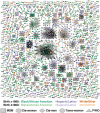Methodological synthesis of Bayesian phylodynamics, HIV-TRACE, and GEE: HIV-1 transmission epidemiology in a racially/ethnically diverse Southern U.S. context
- PMID: 33558579
- PMCID: PMC7870963
- DOI: 10.1038/s41598-021-82673-8
Methodological synthesis of Bayesian phylodynamics, HIV-TRACE, and GEE: HIV-1 transmission epidemiology in a racially/ethnically diverse Southern U.S. context
Erratum in
-
Author Correction: Methodological synthesis of Bayesian phylodynamics, HIV-TRACE, and GEE: HIV-1 transmission epidemiology in a racially/ethnically diverse Southern U.S. context.Sci Rep. 2021 May 10;11(1):10336. doi: 10.1038/s41598-021-89879-w. Sci Rep. 2021. PMID: 33976320 Free PMC article. No abstract available.
Abstract
This study introduces an innovative methodological approach to identify potential drivers of structuring HIV-1 transmission clustering patterns between different subpopulations in the culturally and racially/ethnically diverse context of Houston, TX, the largest city in the Southern United States. Using 6332 HIV-1 pol sequences from persons newly diagnosed with HIV during the period 2010-2018, we reconstructed HIV-1 transmission clusters, using the HIV-TRAnsmission Cluster Engine (HIV-TRACE); inferred demographic and risk parameters on HIV-1 transmission dynamics by jointly estimating viral transmission rates across racial/ethnic, age, and transmission risk groups; and modeled the degree of network connectivity by using generalized estimating equations (GEE). Our results indicate that Hispanics/Latinos are most vulnerable to the structure of transmission clusters and serve as a bridge population, acting as recipients of transmissions from Whites (3.0 state changes/year) and from Blacks (2.6 state changes/year) as well as sources of transmissions to Whites (1.8 state changes/year) and to Blacks (1.2 state changes/year). There were high rates of transmission and high network connectivity between younger and older Hispanics/Latinos as well as between younger and older Blacks. Prevention and intervention efforts are needed for transmission clusters that involve younger racial/ethnic minorities, in particular Hispanic/Latino youth, to reduce onward transmission of HIV in Houston.
Conflict of interest statement
The authors declare no competing interests.
Figures



References
-
- Centers for Disease Control and Prevention. HIV surveillance report: Diagnoses of HIV infection in the United States and dependent areas. Published November 2017. http://www.cdc.gov/hiv/library/reports/hiv-surveillance.html. Accessed October 4, 2020.
Publication types
MeSH terms
Grants and funding
LinkOut - more resources
Full Text Sources
Other Literature Sources
Medical

